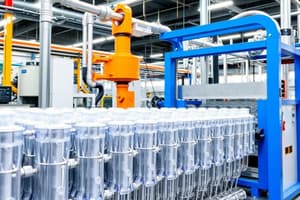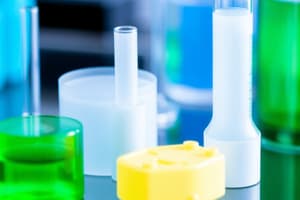Podcast
Questions and Answers
What happens to the physical properties of a thermoplastic above its glass transition temperature and below its melting point?
What happens to the physical properties of a thermoplastic above its glass transition temperature and below its melting point?
- They remain the same
- They change drastically without an associated phase change (correct)
- They form irreversible chemical bonds
- They decompose
What is a defining characteristic of thermoplastics?
What is a defining characteristic of thermoplastics?
- They do not melt when heated
- They form irreversible chemical bonds during the curing process
- They become pliable at elevated temperature and solidify upon cooling (correct)
- They fully crystallize below their melting point
How do thermoplastics differ from thermosetting polymers?
How do thermoplastics differ from thermosetting polymers?
- Thermoplastics form irreversible chemical bonds during the curing process, while thermosets do not
- Thermoplastics may be reshaped when heated, while thermosets do not reform upon cooling (correct)
- Thermoplastics fully crystallize below their melting point, while thermosets do not
- Thermoplastics do not melt when heated, while thermosets decompose
How do thermoplastics differ from thermosets in terms of melting behavior?
How do thermoplastics differ from thermosets in terms of melting behavior?
What allows thermoplastics to be used in various polymer processing techniques such as injection molding and extrusion?
What allows thermoplastics to be used in various polymer processing techniques such as injection molding and extrusion?
Flashcards are hidden until you start studying




